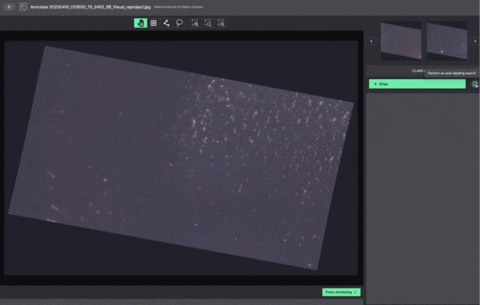TL;DR:
- TurbineOne partners with Defense Innovation Unit (DIU) under a multi-year contract from the Department of Defense.
- Objective is to prototype advanced machine learning (ML) capabilities with FutureG and 5G Office for defense applications.
- Use-cases include enhancing force protection, geolocation of industrial equipment, and revolutionizing intelligence operations centers.
- TurbineOne introduces “Sidekick,” a feature in its Frontline Perception System, employing Zero Shot for automated data-driven model generation.
- TurbineOne extends ML into multi-domain operations and sensor fusion, breaking traditional constraints.
- “Sidekick” translates user queries to visual objects instantly, even in secure networks, boosting analyst efficiency.
- TurbineOne CEO, Ian Kalin, sees potential for both immediate and long-term complex AI queries.
- Initial collaboration focuses on Naval Air Station at Whidbey Island for geolocation and threat detection technologies.
- The partnership signifies a groundbreaking leap in AI-driven perception capabilities for defense intelligence.
Main AI News:
In an exciting collaboration, TurbineOne, a distinguished U.S. intelligence analytics software enterprise, has secured a multi-year contract bestowed upon it by the Defense Innovation Unit (DIU) of the Department of Defense (DoD). The primary objective of this contract is to embark on the prototyping of revolutionary machine learning (ML) capabilities, in conjunction with the Office of the Under Secretary of Defense’s Research and Engineering’s (OUSD R&E’s) FutureG and 5G Office. The endeavor encompasses a diverse array of use-cases, ranging from augmenting force protection to fine-tuning the geolocation of industrial equipment and, ultimately, orchestrating a paradigm shift within intelligence operations centers.
This strategic alignment with the novel contract ushers in the introduction of an innovative facet to TurbineOne’s Frontline Perception System, aptly named “Sidekick.” At its core, Sidekick introduces a groundbreaking capability – the automated generation of data to underpin the construction of a novel detection model. The driving force behind this technology is a computer science methodology known as “Zero Shot,” a concept denoting a computer’s uncanny ability to accurately classify previously unseen objects with remarkable precision. Comparable instances of such a capability include the image search functionality within Google.com or video searches on platforms like Facebook. However, it’s noteworthy that these search engines heavily rely on expansive web infrastructure, meticulous metadata standards, and pre-existing labeled training datasets. In stark contrast, TurbineOne is poised to deliver an unparalleled, zero-shot computer-vision ML model generation prowess, operating on unstructured, untagged data sets that its software has hitherto never encountered.
Leveraging the foundational groundwork laid through its prior collaboration with the military in the Pacific Area of Operations, TurbineOne is orchestrating a revolutionary transformation in the assimilation of imagery from video cameras and satellite feeds, along with non-visual input from sensor arrays. Referred to as “multi-domain operations” and “sensor fusion” within the realm of the DoD, this practice harmonizes seamlessly with TurbineOne’s own “multi-modality” ethos encapsulated in the Zero Shot detection capacity. Traditionally, computer vision applications are bound by the constraints of specific training data types – for instance, annotating static images aids in recognizing patterns in similar static images. However, TurbineOne’s innovation enables users to oversee a myriad of data types emanating from various sensor suppliers, thereby fostering the creation of novel models via a singular, user-friendly platform.
Retired Lieutenant General Bob Ashley, former Director of the Defense Intelligence Agency, lauds TurbineOne’s creation, stating, “I’ve been acquainted with the cream of our nation’s intelligence capabilities, and never have I encountered an intelligence tool as transformative as TurbineOne’s. It has the prowess to pinpoint the minutest detail within a vast expanse of data, thereby drastically enhancing the efficacy of our nation’s intelligence analysts.”
From a technological perspective, TurbineOne’s Sidekick feature harbors an indirect connection to the realm of Generative AI and extensive language models (LLMs). Instead, the enterprise capitalizes on a precursor within the domain of data science – the ML Transformers – to engender object detection models conditioned by textual input. The revolution here lies in the search experience itself; queries undergo instantaneous semantic translation into visual entities, even within secluded data silos devoid of any connection to the public cloud internet – a setting all too common within the secure networks of the DoD. From a user’s standpoint, an intelligence analyst can now simply indicate a data folder and type a request along the lines of “Display all aerial perspectives of ships,” subsequently receiving impeccably precise outcomes.
Ian Kalin, the CEO of TurbineOne, notes, “The realm of AI-driven perception is still in its nascent stages within the industry. We extend our gratitude to DIU for joining forces with us to advance these frontiers. In the immediate future, these tools will empower users to execute straightforward queries such as ‘Present all Chinese vessels in proximity to Taiwan,’ garnering rapid and accurate responses. Looking ahead, analysts will wield the ability to delve into more intricate, predictive scenarios, for instance, ‘Which indicators strongly suggest the initiation of China’s initial phase of a Taiwanese incursion?‘”
Embarking on its maiden venture, the collaboration between DIU, OUSD R&E’s FutureG and 5G Office, and TurbineOne will focus its efforts on the Naval Air Station at Whidbey Island. Kurt Andrews, the Principal Investigator for OUSD R&E’s FutureG and 5G Office, expresses eagerness in the pursuit of pioneering ML-driven geolocation and threat detection technologies with TurbineOne. Andrews emphasizes the universal applicability of the software platform in the realm of intelligence, surveillance, and reconnaissance, underscoring how it equips users with a versatile toolkit tailor-made for military landscapes.
Conclusion:
The collaboration between TurbineOne and DIU sets a new trajectory for AI-driven innovation in the defense sector. With its advanced ML capabilities and the revolutionary “Sidekick” feature, TurbineOne has the potential to reshape intelligence analysis, enabling quick and accurate insights. This strategic move not only empowers defense analysts but also highlights the growing synergy between cutting-edge technology and military applications, foreshadowing transformative shifts in the market landscape.

